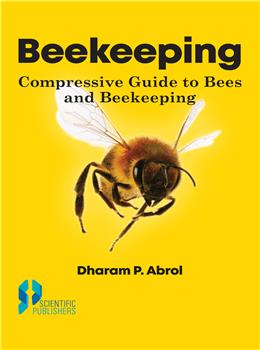Beekeeping : A Compressive Guide to Bees and Beekeeping

- ISBN
- E-ISBN
- Book Format
- Binding
- Language
- Edition
- Imprint
- ©Year
- Pages
- Size (Inch)
- Weight
| S. No. | Chapter name | Action |
|---|---|---|
| 1 | Bee behaviour, learning and communication | Read Chapter |
| 2 | Bee pasturage | Read Chapter |
| 3 | Bee products | Read Chapter |
| 4 | Beekeeping and subsidary industries | Read Chapter |
| 5 | Beekeeping equipments | Read Chapter |
| 6 | Beginning beekeeping and establishment of apiary | Read Chapter |
| 7 | Bibliography | Read Chapter |
| 8 | Biology of the honeybee | Read Chapter |
| 9 | Biotechnological potential of honeybees | Read Chapter |
| 10 | Breeding bees for disease resistance | Read Chapter |
| 11 | Conclusions | Read Chapter |
| 12 | Diagnosis of honey bee diseases | Read Chapter |
| 13 | Diseases and enemies of honey bees | Read Chapter |
| 14 | Diversity of honeybee species | Read Chapter |
| 15 | Evolution and biodiversity of honeybees | Read Chapter |
| 16 | Form and function of the honeybee | Read Chapter |
| 17 | Genetically modified crops and beekeeping | Read Chapter |
| 18 | Glossary | Read Chapter |
| 19 | Handling, processing, storage and marketing honey | Read Chapter |
| 20 | Head Page | Read Chapter |
| 21 | History and importance of beekeeping | Read Chapter |
| 22 | Honey bee nutrition and supplemental feeding | Read Chapter |
| 23 | Honeybee breeding, mass rearing of queens and artificial insemination | Read Chapter |
| 24 | Honeybees as bioindicators of ecosystem health | Read Chapter |
| 25 | Impact of inbreeding depression in honeybees | Read Chapter |
| 26 | Introduction | Read Chapter |
| 27 | Management of honeybee colonies | Read Chapter |
| 28 | Management of wild bees for pollination | Read Chapter |
| 29 | Migratory beekeeping - prospects and problems | Read Chapter |
| 30 | Pesticidal toxicity to bees | Read Chapter |
| 31 | Quarantine control of honeybee diseases | Read Chapter |
| 32 | The use of honeybees bees for pollination | Read Chapter |
| 33 | Two queen colony system for high-honey yields and pollination | Read Chapter |
| 34 | Type of bees | Read Chapter |
| 35 | Value added products from bees and beekeeping | Read Chapter |




